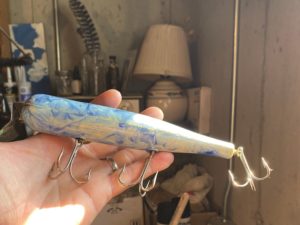Spring in New England has come upon us in its usual manic fashion, vacillating between howling, cold, damp nor’easters and beautiful, warm, summer-like days. But the trend this spring has tended towards weather that’s warmer than usual, as evidenced by ocean water temperatures in the mid- to upper 40s — slightly above what we normally see in mid-April.
The same trend is holding true to our south, and this is important to fishermen up here, because that means a very real possibility of an early arrival of striped bass. The striped bass we catch migrate here from the Chesapeake Bay area, the Delaware Bay area, and the Hudson River. The fish go to brackish areas there to spawn. We do get “holdover bass,” which stay here all winter, but they are small, sexually immature fish.
The word from points south is that striped bass are way ahead of schedule. They are already catching them very well off of New Jersey and the south shore of Long Island. This would suggest they could be here by mid-May. The speed of the migration is purely temperature driven; as long as ocean water temperatures keep rising, they will keep coming north. A protracted cold snap, however, could slow the migration down a bit.

Rules for recreational catches are mostly the same this year. We are still allowed one fish per day in a slot size of 28 to 35 inches.
We still cannot use a gaff to bring a fish into the boat if we are unsure whether it is a keeper or not.
The notable change is there are no more exemptions to the 2020 rule putting an end to the use of J hooks when bait fishing for striped bass. Everyone has to use circle hooks now. The reasoning behind this is that circle hooks have a tendency to not go so deep into a fish’s gullet, which, theoretically, should cut down on released-fish mortality.
But this is where the rules make me scratch my head and say, “Huh?”
If you are fishing for any other species using a J hook and happen to inadvertently catch a striped bass of keeper size on it, you are not allowed to keep that bass.
And it gets worse. Because, conversely, if you are using a swimming plug, which typically has three treble J hooks on it, that’s OK to fish with. Even for catch-and-release striped bass not in the keeper slot size. Also, if you fish with a bucktail jig or a diamond jig you can use the traditional J hooks — they all come with them.
There is no question that swimming plugs with their three treble J hooks are responsible for many of the fatalities that occur when a non-keeper bass is caught and returned to the ocean. How can a fish with its mouth and gullet impaled by as many as nine hooks possibly survive?
The logic — or lack thereof — in these rules continues to astound me.
The commercial quota for striped bass will be the same as last year, at 735,000 pounds. But there is talk of expanding the length of the season with one more day per week open to commercial harvesting of striped bass. Nothing, as far as I have heard, is written in stone yet. Stay tuned.



